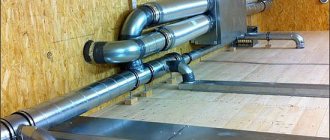Safe operation of electrical appliances is impossible without grounding. This ensures human protection from electric shock and guarantees long-lasting operation of household appliances. In old houses there is no protective grounding, but outdated energy supply systems are being replaced by new ones.
To make grounding in an apartment or private house yourself, you need to figure out what electrical system is present there and what is needed to connect it to the ground loop.
Why do you need grounding in an apartment?
Grounding means connecting a network point to a grounding device. With its help, they achieve a reduction in voltage to a level that is safe for humans. In other words, grounding is a protection that will work in the event of a hole, voltage surge or potential buildup, and will drain dangerous current into the ground.
Grounding can be operational or protective. If the first serves for the functioning of some specific electrical appliances and devices, then the second is intended to protect a person from electric shocks in an apartment or private house. Modern safety standards recommend laying internal electrical wiring of three cores and connecting all devices to a ground loop.
Reference! The color of the ground wire is in most cases yellow-green. Zero is blue or cyan, and phase can be black or red.
The following need grounding:
- sockets;
- household appliances with a metal body. In an apartment this includes a bathtub, a computer system case, a boiler, a refrigerator, a washing machine and other large household appliances.
Example of the need for grounding
The boiler installed to heat water in the apartment failed and shorted the electricity to the building. All the batteries and pipes in the apartment were under voltage. The unsuspecting man decided to drink water and tried to open the tap. The moment the hand touched the valve, the network closed and the current passed through the human body to the floor.
If the boiler were grounded, the current would go into the ground, and the machine would turn off the power supply to the device, or the batteries and pipes connected to the ground would have practically zero potential. In both cases, the electric shock could have been avoided.
Search using the device
One of the best methods for finding out where the wiring is in prefabricated houses is a device for finding hidden cables . There are several variations of the device that work on different principles. The most primitive ones measure the voltage of the magnetic field: current passing through a wire creates lines of force around it, which are recorded by the device. This method has a drawback and it is quite significant: the wire may be de-energized and safely “forgotten” in the wall by the master during a previous redevelopment. Also, such solutions have rather low noise immunity, although modern solutions do not have this drawback. Homemade devices also deserve special attention, but in most cases the apartment owner will not have the time, parts, or necessary skills to create it.
Another option is a small metal detector . It works in reverse. If the first type of device recorded the magnetic field emitted by the wire, then the second one generated it. In practice, this may not provide any particular advantages when searching for cables, although only such a device can find de-energized sections of the network. Another thing is that, in addition to conductors, he is also looking for fittings: when working with a hammer drill, this will be a huge plus. So in the long term, it is recommended to purchase just such a hidden wiring sensor.
What systems exist
In apartment buildings with a voltage of 220W, several grounding systems are possible, the basic standards and requirements for which are listed in paragraph 1.7 of the PUE. The systems are marked. The first letter indicates the state of the neutral of the power source relative to ground:
- I – isolated;
- T – grounded.
The second is the state of open conductive parts relative to the ground:
- T – conductive parts are grounded;
- N – connected to a grounded neutral.
The latter denotes the principle of combining the neutral protective and working conductors:
- S – conductors are separated;
- C – functions are combined in one conductor.
According to GOST R 50571.2-94, neutral conductors are designated:
- N – worker;
- PE – protective;
- PEN – a combination of protective and working.
Systems:
- TN-C. The system is common in old apartment buildings and is characterized by the absence of a separate grounding conductor. Throughout the entire network, the neutral protective conductor is combined with the working conductor (PEN). Such protection was used in Khrushchev and Brezhnevka buildings. From the point of view of electrical safety, it is one of the most unreliable. You can determine that this particular connection system is in the apartment by looking at the entrance panel. Inside there will be four incoming cables (PEN and three phases) and two leaving the apartment (PEN and phase). There will be no protective contacts in the sockets.
- TN-S. The system replaced the outdated and notoriously dangerous TN-C. The working and protective conductors are separated at substations and do not intersect along their entire length. Such a connection can only be determined in the input distribution device, access to which in apartment buildings is limited. There are five cables at the entrance (3 phases, PE and zero), three go into the apartment (PE, phase, zero).
- TN-CS. This system is an intermediate option between the previous two, a modernization of the outdated TN-C system in residential premises. Throughout the entire length, the neutral protective conductor and the working conductor are combined, and at the entrance to the building their separation begins.
- TT. Such a system is optimal where all others will not provide sufficient electrical safety, for example, in detached private houses, metal containers or shopping pavilions. Voltage is supplied through four wires (three phases and zero). The operating principle is based on the fact that the protective neutral conductor is grounded independently of the working conductor. There is no connection between them, and ground loops are not communicated.
- IT. Voltage is transmitted through three phases of the wires. There is a protective circuit on the end-user side; the source neutral is isolated. The system is used in installations that require uninterrupted power supply and require constant monitoring.
Circuit design
Components
The previously mentioned grounding resistance (Rз) of the circuit is the main parameter controlled at all stages of its operation and determines the effectiveness of its use. This value must be so small as to provide a free path for the emergency current tending to flow into the ground.
Note! The most important factor that has a decisive influence on the value of grounding resistance is the quality and condition of the soil at the site of the installation. Based on this, the charger in question or the ground loop of the circuit breaker (which in our case is the same thing) must have a design that meets the following requirements:. Based on this, the charger in question or the ground loop of the charge circuit (which in our case is the same thing) must have a design that meets the following requirements:
Based on this, the charger in question or the ground loop of the charge circuit (which in our case is the same thing) must have a design that meets the following requirements:
- It must include a set of metal rods or pins with a length of at least 2 meters and a diameter of 10 to 25 millimeters;
- They are connected to each other (necessarily for welding) by plates of the same metal into a structure of a certain shape, forming a so-called “grounding conductor”;
- In addition, the device includes a supply copper busbar (also called electrical) with a cross-section determined by the type of equipment being protected and the magnitude of the drain current (see the table in the figure below).
Table of busbar sections
These component devices are necessary to connect the elements of the protected equipment with the descent (copper busbar).
Differences in device location
According to the provisions of the PUE, the protective circuit can have both external and internal design, and each of them is subject to special requirements. The latter establishes not only the permissible resistance of the ground loop, but also stipulates the conditions for measuring this parameter in each particular case (outside and inside the object).
When dividing grounding systems according to their location, it should be remembered that only for external structures the question of how the grounding resistance is normalized is correct, since it is usually absent indoors. Internal structures are characterized by wiring of electrical busbars along the entire perimeter of the premises, to which grounded parts of equipment and devices are connected through flexible copper conductors.
For structural elements grounded outside the facility, the concept of re-grounding resistance is introduced, which appeared as a result of the special organization of protection at the substation. The fact is that when forming a neutral protective conductor or a working conductor combined with it at the supply station, the neutral point of the equipment (step-down transformer, in particular) is already grounded once.
Therefore, when another local grounding is made at the opposite end of the same wire (usually a PEN or PE bus connected directly to the consumer panel), it can rightfully be called repeated. The organization of this type of protection is shown in the figure below.
Important! The presence of local or repeated grounding allows you to insure yourself in case of damage to the protective neutral wire PEN (PE - in the TN-CS power supply system). Such a malfunction is usually found in technical literature under the name “zero burnout.” Such a malfunction is usually found in technical literature under the name “zero burnout”
Such a malfunction is usually found in technical literature under the name “zero burnout.”
Grounding for a new building
In modern new buildings built after 1998, TN-S and TN-C-S grounding systems are used. This means that they have dedicated grounding. The wiring is laid along a three-wire system connected to the ground loop.
The following are supplied to the riser:
- three phases;
- zero working conductor;
- protected conductor.
A grounding wire is installed throughout the apartment, and sockets with contacts are installed in the rooms. After which the phase and working wire N are connected to the corresponding buses, and PE to the panel.
Removing the old socket
When carrying out repairs, it is often necessary to replace old power points with new ones, especially in Khrushchev or Stalin buildings, old-type panel houses. Sometimes such sockets are built into the wall without a socket box. Here the master must act in the following sequence:
- The power is turned off at the distribution panel.
- The socket panel is removed by unscrewing the fasteners.
- Using a screwdriver, the technician disconnects the wires from the terminals and removes the old structure.
- It is important to release part of the power cable in order to freely form a socket for installing a new glass.
- Otherwise, all actions are performed by analogy with installing an internal (built-in) power point.
If the power cable is short, you can lengthen it. All connections are carefully insulated.
How to make grounding in an apartment if there is none
In old houses, a TN-C system is installed, which does not have grounding, and a two-wire wire is laid (phase and neutral). To ground the apartment, you will have to install new wiring, install an RCD, or install a circuit.
RCD connection
A residual current device, or, in other words, an RCD, will save a person from electric shock if there is no grounding in the house. Phase and neutral wires pass through the device. At the moment of electricity leakage, it determines the difference between the current strength passing between them and disconnects the contacts, thereby de-energizing a section of the network.
Reference! Electricians advise connecting an RCD regardless of whether there is grounding in the house or not.
There are two options for connecting an RCD:
- For the whole house. In this case, you can protect all electrical appliances in the apartment from leakage, from large household appliances to lamps. This will require a more powerful and expensive device. When the protection is triggered, electricity will be turned off everywhere, and each connected device will have to be checked for leakage separately.
- Per room or specific device. A less powerful RCD is installed only on “dangerous” lines, for example, in the bathroom, kitchen, basement, or on a specific device, such as a washing machine or electric stove. If the apartment has devices that consume more than 1.2 kW, then it is recommended to install a separate circuit breaker and RCD for each of them.
The device has two input and two output terminals (phase and zero). Installation is carried out according to the diagram:
Installation rules:
- The RCD is installed between the input switch and the circuit breaker;
- the power of the RCD should slightly exceed the power of the machine installed on it;
- The correct operation of the RCD is checked by connecting the household appliance under load to the network into which it was installed.
Installation of your own circuit
You can make your own grounding circuit with your own hands both in a private house and in an apartment building. In the second case, the work must be coordinated with the management company and comply with the requirements of the PUE.
Work order:
- A single-core PE wire is pulled along the riser to the basement. It is recommended to use copper wire with a cross-section of at least 4 square meters. mm.
- A ground electrode is installed near the house. Typically, stainless steel scraps are used, which are welded in the shape of a triangle.
- One end of the wire is connected to the finished structure, the other is fixed in the shield.
- The grounding of the apartment is connected to the shield.
Important! It is prohibited to use reinforcement as a grounding conductor. The reason is the outer hardened layer, which enhances the distribution of current, and the rapid rusting process.
Dangerous defense option
It is unacceptable to solve the grounding problem by connecting a PE wire to the water supply or gas supply system. In the event of a leak, the current will flow not through the wires, but through the pipes and battery, which can lead to electric shock not only to those living in the apartment grounded in this way, but also to neighbors.
Let's analyze the situation with diagrams
From the point of view of the flow of electric current, there is no difference between grounding and grounding.
The neutral wire in any case has electrical contact with physical ground. Accordingly, when a phase is shorted to the housing, the same short circuit will occur and the circuit breaker will turn off. Of course, (subject to proper connection: the socket must have a third ground contact, just like an electrical appliance. For this reason, electricians, violating the requirements of the Electrical Installation Rules, often separate the ground bus from the zero contact of the input panel.
Let's imagine a situation where the neutral wire is broken for some reason:
- loss of contact due to corrosion (in old high-rise buildings this is a working situation);
- mechanical rupture of the cable due to repair work with violations of technology (unfortunately, also not uncommon);
- unauthorized intervention by a home-grown “electrician”;
- accident at the substation (only the zero bus may be disconnected).
In the diagram it looks like this:
When organizing protective grounding, the electrical circuit between the physical “ground” and the grounding contact of the electrical appliance is broken. The installation becomes defenseless. In addition, a free phase without a load can create a potential equal to the input voltage at the nearest substation. Typically this is 600 volts. You can imagine the damage that will be caused to the electrical equipment that is turned on at this moment. In this case, there is no current leakage to the physical ground, and the circuit breaker will not trip.
Imagine that at this moment you simultaneously touch a phase (a breakdown on the body of an electrical installation) and a metal object that has a physical connection with the ground (a water tap or a heating radiator). You can get electrocuted at 600 volts.
Now let's see what the difference is between grounding and neutralizing (in our diagram). If the zero bus breaks, the power to all electrical installations in this circuit will simply disappear. There will be no electric shock under any circumstances: the electrical circuit between the physical ground and the grounding contact of electrical appliances is not broken. We have already preserved our health. Now let's see what happens to electrical installations. The maximum damage is a burnt-out incandescent lamp closest to the input panel. Moreover, trouble will only occur if the voltage on the phase wire increases. The current strength will increase (according to Ohm's law), the circuit breaker will work, and perhaps other electrical appliances will not be affected.
It is for this reason that the PUE strictly prescribes: protective grounding and grounding of electrical installations must be organized independently of each other, using different lines.
For reference: Wire color coding is usually used:
- The phase is brown or white.
- The working zero is blue.
- Protective grounding is a yellow-green shell.
If you have a modern home, then grounding and grounding are carried out in accordance with the Electrical Installation Rules. This can be easily checked by looking at the input cable in the panel. In addition, you can check the correct connection yourself.
Tips and tricks
- Electricians recommend grounding all household appliances and sockets in the apartment;
- Electrical appliances cannot be grounded in a chain through each other. This may cause electromagnetic incompatibility and ground loop failure;
- special terminals should be used; twisting at the joints is not allowed;
- Only one wire can be connected to each PE bus terminal.
Grounding will make it safe to use electrical appliances in the apartment. There are several connection systems, the most common is TN-C; it does not have a separate grounding conductor and is outdated. To protect a person from electric shock, you can install an RCD and assemble your own protective circuit. If you follow safety precautions and PUE standards, this will not cause much difficulty.
Dangerous protection schemes
When multi-storey buildings used metal pipes for plumbing and heating systems, some would-be electricians connected a PE circuit to them. This is a dangerous game, because a broken phase on any household appliance created a leakage current that followed the path of least resistance, that is, it moved along the grounding in the apartment. In this case, an electric shock could occur from contact with a pipe or heating radiator. And not only in this apartment, but also in others, because the risers are a single network, both in the plumbing and in the heating. Fortunately, today everyone has switched to plastic pipes.
There are cases when sockets were grounded, in which the neutral and ground terminals were connected with a jumper. The danger is that if the neutral circuit breaks, all the current will begin to flow through the grounding network. That is, the voltage will transfer to the housing of all devices in the apartment.
Where can I get grounding in the floor panel?
Here's everything you need to know about grounding in an apartment building. It is good if it is already provided for by the building design. But if there is no grounding, then you can do it yourself. Options are offered to you, but, as practice shows, the simplest and most effective is to ground the wiring and sockets using an RCD.
How to make grounding in an apartment and why is it necessary?
Grounding is a deliberate electrical connection of an electrical network, equipment or installation in order to prevent injuries dangerous to the life and health of humans or animals.
Before making grounding in an apartment, you need to gain basic knowledge in this area, and then strictly follow the technology for arranging a protective circuit system.
On the issue of safety
Please note once again: it is better to invite an electrician to check the functionality of grounding in sockets. He will take measurements and give a conclusion based on the results. But if you still decide to try one of the methods of self-checking, you need to be well prepared and take all possible precautions:
Avoid touching exposed wires and metal parts with your hands.
- Place a rubber mat under your feet.
- Handle only isolated parts.
- Don't check alone. So that “if something happens” there is someone to react.
But as we have already said several times above, it is better to call an electrician. You may be able to connect a grounded outlet yourself, but it’s better to entrust the quality of the work to a professional.
Sources
- https://kak-sdelano.ru/elektrica/kak-podklyuchit-rozetku-s-zazemleniem
- https://ichip.ru/sovety/ekspluataciya/nuzhny-li-doma-rozetki-s-zazemleniem-719392
- https://YaElectrik.ru/elektroprovodka/kak-podklyuchit-rozetku-s-zazemleniem
- https://ProFazu.ru/provodka/ustanovochnye/rozetka-s-zazemleniem.html
- https://sovet-ingenera.com/elektrika/rozetk-vykl/kak-podklyuchit-rozetku-s-zazemleniem.html
- https://odinelectric.ru/wiring/rozetki-i-vyklyuchateli/kak-podklyuchit-rozetku-s-zazemleniem
- https://elektroznatok.ru/provodka/podklyuchenie-rozetki-s-zazemleniem
Installation of the overhead option: step-by-step instructions
First, let's look at the process of connecting a surface-mounted socket to a cable hidden hidden in the baseboard box.
Step 1: In order to understand the procedure for installing a grounded socket, let's start with the simplest overhead type. Step 2: Mark on the wall the location of the future outlet, cut a hole in the baseboard for the wiring and route the cable through it. Step 3: Before installation, let's disassemble the socket into its components by unscrewing the fastening screw in the center of the front part. Step 4: Disassemble the socket into its components. In this model, the wiring mechanism is permanently attached to the mounting plate. Step 5: Prepare the wiring for connecting the outlet. We remove the general insulation from the cable, then strip the outermost 0.5 - 0.8 cm of insulation from the three wires. Step 6: Mark through the holes in the mounting plate the points through which the device will be attached to the wall. Step 7: At the marked points we drill holes into which we will install fasteners. We install plastic dowels into the concrete wall. Step 8: We install plastic devices at the drilled points to ensure reliable fixation with self-tapping screws. Socket from Schneider Electric from the Etude collection. Preparing the cable for connecting the device Disassembling electrical installation equipment. Components of the electrical installation device. Preparing the wiring for connecting the outlet. Marking the socket attachment points. Drilling holes in the wall according to the markings. Installing dowels into drilled holes
After completing the preparatory steps, we can safely begin connecting the socket mechanism to the grounded wiring.
Step 9: We fix the socket mechanism together with the mounting platform that is structurally fused with it to the wall with self-tapping screws. Step 10: We insert the edges of the wires, cleared of insulation, into the spring terminals of the socket. Grounding in the center, phase to terminal L, neutral wire to N
Step 11: Before attaching the front part of the case, we prepare it for installation by cutting out a semicircle in the side part necessary for a tight fit to the wall. Step 12: Close the device with the mechanism connected to the wiring with the front part of the case, align it and fix it with a screw. Fastening the mounting platform and mechanism. Connecting the device to the wiring. Preparing the front part for mounting. Fastening the front part of the socket body
When it is necessary?
It is unlikely that you will encounter a lack of grounding in a new apartment. New houses are put into operation if they comply with all safety regulations. That is, grounding there is provided for by the design. But for low-rise buildings there are two options for connecting to electrical networks:
- two-phase;
- three-phase.
Important! In the first case, you will have to take care of safety yourself. The same must be done if you bought an apartment on the secondary market, and the house was built a very long time ago. This is especially important if the house is wooden - the slightest problem in the electrical network can cause a short circuit and fire.
Connecting correctly
Before installation, you need to determine what type of wiring is in the wall. This step requires removing the old outlet, which will expose the number of wires. If there are only two wires, there is no grounding, and we see only the neutral wire, as well as the phase.
Important: before installing a grounded outlet, it is recommended to ensure that you have the necessary tools for an electrician: an indicator screwdriver and a multimeter.
For correct connection, all stages of work must be followed:
- Turn off the power supply at the panel;
- Carefully inspect the panel and make sure that the electricity is turned off;
- Next, using a special indicator (the so-called indicator screwdriver), you need to make sure that there is no phase on all 3 wires, or more precisely on their bare parts;
- Unscrew the screw on the body, loosen the tabs, remove the old product;
- If the socket box is in poor condition, it can be cleaned or replaced with a new one;
- Remove the external insulation;
- We clean the ends of the wires.
A very important point - always leave a supply of wires, because you will connect them to the outlet BEFORE installing it in the wall!
- Connect the cables to the socket and tighten the screw;
- We connect the third cable to the socket - grounding to the terminal marked as “PE” or with a special sign:
- We fix the case with screws;
- Screw on the housing cover.
Attention! The ground wire is usually colored yellow-green, but always confirm the final conclusion with an indicator screwdriver.











